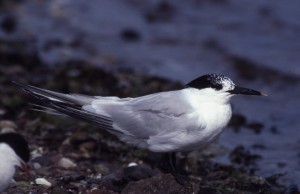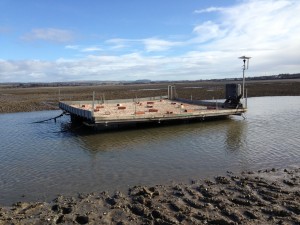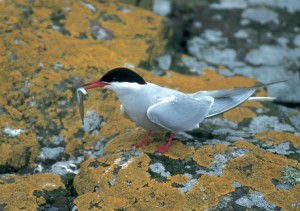Basin Notes – 15th April
The unusually cold weather we experienced during March left us all questioning what would happen to the summer migrants due to arrive on our shores to breed. The specially constructed sand martin bank at Montrose Basin Visitor Centre was vacant weeks after sand martins were due to arrive. The past few years saw these birds flitting about the wall feeding on insects over the adjacent pond before the end of March after a long migration from wintering grounds in Africa. Two weeks into April, news reached us of sand martins in the local area but it wasn’t until 14th April (Sunday morning) when the first sand martin of the season was seen at the wall at the Visitor Centre. We are now all hoping the warmer weather will continue, bringing more insects for these birds to feed on.

While sand martins returned a couple of weeks later than we would expect, we were yet to find out what would happen to the migration of the terns that breed in the area. There wasn’t long to wait to find out as later that day, during the monthly Wetland Bird Survey, a Common Tern was seen soaring overhead at Scurdie Ness. Several species of tern breed in colonies in Scotland and are well known in Montrose as some colonies breed on rooftops of local businesses in the town. The first terns to return to Scotland are usually Sandwich Terns. Easily distinguished from other terns by their black bill with a yellow tip and crested black cap on their head, some Sandwich Terns are seen as early as March though the main passage is usually in April. These birds have wintered in the Mediterranean or South and West coasts of Africa. Though they frequent estuaries and are regularly seen at Montrose Basin during the breeding season, they nest on rocky offshore islands. By mid-April, Common Terns are expected to return following their migration from coasts of the Pacific, Indian or Atlantic Oceans, and it is this species that was seen on Sunday. Arctic terns have the longest migration as they winter south of the Tropic of Capricorn with many reaching pack ice of the Antarctic!! Arctic and Common terns are very tricky to tell apart, but Arctic terns lack the black tip on the end of their red bill.

Arctic Terns and Common Terns are the species that we are used to seeing and hearing in Montrose. Apart from the colonies of Arctic Terns that nest on rooftops in the town, a colony of Common Terns breed on the specially constructed tern raft on the Montrose Basin. The raft aptly named ‘ The Maid of Sterna Stuff’ (after the scientific name for Common tern: Sterna hirundo, or Arctic Tern: Sterna paradisaea) is an ideal habitat for terns to nest and would attract either Common or Arctic Terns, but as Common Terns are the first to return from their wintering grounds, they tend to take up the raft for the summer. The raft has been in situ for 5 years now and was originally funded by GaxoSmithKline. This year the team of staff and volunteers at Scottish Wildlife Trust Montrose Basin, have been working hard maintaining the raft and modifying it for the coming season. The base of the raft has been replaced as the wood was beginning to rot away – a sign of being moored on the Basin for the past five years, and the drainage and been improved. The addition of splash boards to the sides of the raft is a modification intended to prevent waves lapping over the sides and washing away the substrate that the terns make their nests in. The substrate on the raft is crushed scallop shell, which is a dense enough material not to blow away in strong winds. Common terns’ nests are nothing more than subtle scrapes in the crushed shell in which they lay their eggs.

The main threat to the success of the breeding season for the terns on the raft are egg predation from crows or predation of young from peregrine falcons. Nesting in a colony offers the birds some protection as they enjoy safety in numbers. The past breeding season seemed to go particularly badly for terns, with reports of the rooftop colonies in the town not doing well, we were disappointed to see our terns abandon the raft after laying eggs. The heavy rainfall throughout the breeding season of 2012 meant the raft was likely to have flooded as the drainage in place would have been overwhelmed. This may have chilled the eggs and caused the Common terns to abandon the raft. We observed activity on the raft throughout the season and were pleased to see terns re-appear later on and even conduct their courtship display. This indicates the terns have not given up on the site and are likely to return to breed this year. With the first Common tern already sited in the area, it may not be long before we see the birds land on the raft. In previous years, the terns have landed on the raft after their migration, seemingly claiming it as the site for their colony and remain there for some time. The terns then leave the raft for a few weeks before returning to breed.
The tern raft can be viewed through powerful optics from the Visitor Centre at Montrose Basin allowing all to witness the impressive behaviour of these birds. The courtship display is fascinating to watch where the male will circle the female with wings opened, tail raised, and neck stretched with head pointing down. The male can be seen presenting the female with a fish, though he will often not release it until he feels the female has responded by displaying to him in return. The accuracy of the terns diving into the basin at high speed after small fish such as sand eels or sprats after hovering over the water is something quite breathtaking to watch. We are all fortunate to be able to observe the graceful, controlled flight of both Common and Arctic terns and should all take the time to appreciate the birds that are deservedly known as ‘sea swallows’.
Anna Cheshier (SWT Montrose Basin Ranger)
Help protect Scotland’s wildlife
Our work to save Scotland’s wildlife is made possible thanks to the generosity of our members and supporters.
Join today from just £3 a month to help protect the species you love.
Preface
The unusually cold weather we experienced during March left us all questioning what would happen to the summer migrants due to arrive on our shores to breed. The specially constructed …
